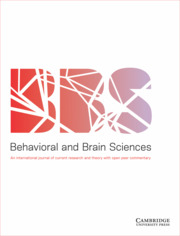No CrossRef data available.
Article contents
Teaching interactions are based on motor behavior embodiment
Published online by Cambridge University Press: 08 June 2015
Abstract
In Kline's target article, the role of motor behavior in teaching is missing. However, it is so important that we cannot avoid taking into account the movements of another person when performing our own movements. Moreover, the state of mind is embodied. Consequently, teaching should integrate the role of motor behavior to enhance teacher/learner social interactions.
- Type
- Open Peer Commentary
- Information
- Copyright
- Copyright © Cambridge University Press 2015
References
Issartel, J., Marin, L. & Cadopi, M. (2007) Unintended interpersonal co-ordination: Can we march to the beat of our own drum?
Neuroscience Letters
411:174–79.Google Scholar
Mehrabian, A. & Ferris, S. R. (1967) Inference of attitudes from nonverbal communication in two channels. Journal of Consulting Psychology
31(3):248–52.Google Scholar
Neda, Z., Ravasz, E., Brechet, Y., Vicsek, T. & Barabasi, A.-L. (2000) The sound of many hands clapping. Nature
403:849–50.Google Scholar
Schmidt, R. C. & O'Brien, B. (1997) Evaluating the dynamics of unintended interpersonal coordination. Ecological Psychology
9:189–206.Google Scholar
van Baaren, R. B., Holland, R. W., Kawakami, K. & van Knippenberg, A. (2004) Mimicry and pro-social behavior. Psychological Science
15:71–74.CrossRefGoogle Scholar
van Ulzen, N. R., Lamoth, C. J. C., Daffertshofer, A., Semin, G. R. & Beek, P. J. (2008) Characteristics of instructed and uninstructed interpersonal coordination while walking side-by-side. Neuroscience Letters
432:88–93.Google Scholar
Varlet, M., Marin, L., Capdevielle, D., Del-Monte, J., Schmidt, R. C., Salesse, R. N., Boulenger, J.-P., Bardy, B. & Raffard, S. (2014) Difficulty leading interpersonal coordination: Towards an embodied signature of social anxiety disorder. Frontiers in Behavioral Neuroscience
8:1–9.Google Scholar
Varlet, M., Marin, L., Raffard, S., Schmidt, R. C., Capdevielle, D., Boulenger, J. P., Del-Monte, J. & Bardy, B. G. (2012) Impairments of social motor coordination in schizophrenia. PLoS One
7:e29772.Google Scholar
Wiltermuth, S. S. & Heath, C. (2009) Synchrony and cooperation. Psychological Science
20(1):1–5.Google Scholar



Target article
How to learn about teaching: An evolutionary framework for the study of teaching behavior in humans and other animals
Related commentaries (38)
Another way to learn about teaching: What dogs can tell us about the evolution of pedagogy
Childhood and the evolution of higher-effort teaching
Clarifying the range of social-cognitive processes subserving human teaching
Cognitive mechanisms matter – but they do not explain the absence of teaching in chimpanzees1
Cognitive universals and cultural variation in teaching
Cooperation in human teaching
Cultural variant interaction in teaching and transmission
Does all teaching rest on evolved traits?
Evolutionary mechanisms of teaching
Eyes on the price: Human culture and its teaching
Human teaching and learning involve cultural communities, not just individuals
Is tolerance really teaching?
Learning about teaching requires thinking about the learner
Learning in and about opaque worlds
Measuring teaching through hormones and time series analysis: Towards a comparative framework1
Mind, brain, and teaching: Some directions for future research
More examples of chimpanzees teaching
Multiple dilemmas of help and counteraction to teaching in complex social worlds
On the persistent gray area between teaching and punishment
Play to learn, teach by play
Robot teachers: The very idea!
Subjectivity may hinder the application of Kline's teaching framework in comparative contexts
Systematic data are the best way forward in studies of teaching
Teacher and learner: Supervised and unsupervised learning in communities
Teaching as an exaptation
Teaching interactions are based on motor behavior embodiment
The active role played by human learners is key to understanding the efficacy of teaching in humans
The benefits of an evolutionary framework for the investigation of teaching behaviour: Emphasis should be taken off humans as a benchmark
The lowest common denominator between species for teaching behaviors
The mutual relevance of teaching and cultural attraction
The parental brain: A neural framework for study of teaching in humans and other animals
The proximate-ultimate confusion in teaching and cooperation
The study of teaching needs an inclusive functional definition
To what adaptive problems is human teaching a solution?
Understanding teaching needs development
Variations in teaching bring variations in learning
What is teaching? A clear, integrative, operational definition for teaching is still needed
“Teaching is so WEIRD”
Author response
Much to learn about teaching: Reconciling form, function, phylogeny, and development